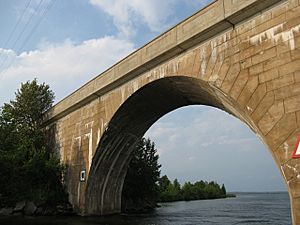Canal Lake Concrete Arch Bridge facts for kids
Quick facts for kids Canal Lake Concrete Arch Bridge |
|
|---|---|
 |
|
| Coordinates | 44°33′29″N 79°02′45″W / 44.55801°N 79.04592°W |
| Carries | Centennial Park Road |
| Crosses | Canal Lake |
| Locale | Kawartha Lakes (Ontario) |
| Owner | City of Kawartha Lakes |
| Heritage status | National Historic Sites of Canada |
| Characteristics | |
| Material | Reinforced concrete |
| Total length | 202 feet (62 m) |
| Width | 16 feet (4.9 m) |
| Height | 29 feet (8.8 m) |
| Water depth | up to 15 feet (4.6 m) |
| Number of spans | 1 |
| Clearance below | 29 feet (8.8 m) |
| History | |
| Designer | Department of Railways and Canals |
| Construction begin | 1905 |
| Construction end | 1905 |
| Opened | 1905 |
| Official name: Canal Lake Concrete Arch Bridge National Historic Site of Canada | |
| Designated: | 24 June 1988 |
| Lua error in Module:Location_map at line 420: attempt to index field 'wikibase' (a nil value). | |
The Canal Lake Concrete Arch Bridge is a special bridge in Ontario, Canada. It crosses part of Canal Lake, which is a waterway connecting Balsam Lake and Lake Simcoe. You can find it near the town of Bolsover.
This bridge is super important because it's the earliest known bridge in Canada made with reinforced concrete. This means it uses concrete with steel inside to make it extra strong. It was built using a special method called the Melan System. In 1988, it was named a National Historic Site of Canada. This honor recognizes it as a big step forward in how bridges were built in Canada.
Contents
How Was the Bridge Built?
Designing a Strong Bridge
The Department of Railways and Canals, a government group, designed the bridge. It was built in 1905. At first, it was going to be a regular concrete arch bridge. But before they started building, they decided to make it even better.
They added reinforced concrete using a method from Josef Melan. He was an engineer who came up with this idea in the 1890s. Some changes included adding strong supports, called struts, under the arch. They also made the arch and its supports, called abutments, a bit lighter. The concrete itself has curved steel bars, or girders, inside to make it stronger.
Understanding the Bridge's Shape
The bridge has a "closed spandrel" design. This means the road on top, called the deck, is supported by walls that transfer its weight to the arch. The arch is curved with a radius of 30 feet (9.1 m).
There's plenty of space underneath for boats to pass. The clearance is 29 feet (8.8 m) high. The bridge deck is 16 feet (4.9 m) wide and stretches 202 feet (62 m) across the lake. It's held firmly in place by strong reinforced concrete abutments on each side. The concrete walls are even decorated to look like stone blocks, similar to older stone bridges.
Recent Repairs to the Bridge
The bridge was updated between April 2018 and February 2019. A company called GMP Contracting Ltd. did the work. They fixed the concrete, smoothed the surface, and replaced the road deck. This helps keep the historic bridge safe and strong for many more years.
A National Historic Site
Why is it So Important?
The Canal Lake Concrete Arch Bridge became a National Historic Site of Canada on June 24, 1988. It earned this title for a few key reasons:
- It was one of the first bridges in Canada to use concrete.
- It's the earliest known bridge in Canada to use reinforced concrete.
- It's closely connected to the Trent–Severn Waterway, an important Canadian canal system.
This bridge is one of only a few "mass concrete" bridges built in North America. It's seen as a "transitional structure." This means it shows a change from older stone arch bridges to the newer, stronger reinforced concrete bridges we see today.
Honoring its History
On August 30, 2008, a special plaque was put up at the bridge. Bruce Stanton, who was a Member of Parliament at the time, helped unveil it. The plaque explains that the Canal Lake Concrete Arch Bridge is a major achievement in Canadian engineering. It helped lead the way for building many large, strong bridges using reinforced concrete.

